Publication Information
ISSN: 2641-6816
Frequency: Continuous
Format: PDF and HTML
Versions: Online (Open Access)
Year first Published: 2018
Language: English
| Journal Menu |
| Editorial Board |
| Reviewer Board |
| Articles |
| Open Access |
| Special Issue Proposals |
| Guidelines for Authors |
| Guidelines for Editors |
| Guidelines for Reviewers |
| Membership |
| Fee and Guidelines |
 |
Evaluation of the Physico-chemical, Thermal, and Behavioural Properties of Consciousness Energy Healing Treated Thiamine Hydrochloride
Mahendra Kumar Trivedi1, Snehasis Jana2*
1Trivedi Global, Inc., Henderson, USA
2Trivedi Science Research Laboratory Pvt. Ltd., Thane (W), India
Received Date: September 20, 2019; Accepted Date: September 30, 2019; Published Date: October 9; 2019
*Corresponding author: Snehasis Jana, Trivedi Science Research Laboratory Pvt. Ltd, Thane (W), Maharashtra, India. Tel: +9102225811234; Email: publication@trivedieffect.com
Citation: Trivedi MK, Jana S (2019) Evaluation of the Physico-chemical, Thermal, and Behavioural Properties of Consciousness Energy Healing Treated Thiamine Hydrochloride. Adv Nutri and Food Sci: ANAFS-147.
Abstract
Thiamine hydrochloride plays an important role in the cellular production of energy and is also responsible for enhancing normal neuronal activities. This study was designed to determine the impact of the Trivedi Effect® on the physicochemical, spectral, and thermal properties of thiamine hydrochloride. For this, the sample was divided into two parts, i.e., control and treated. The control part was kept untreated, while the treated part received the Trivedi Effect®-Consciousness Energy Healing Treatment remotely by a renowned Biofield Energy Healer, Mr. Mahendra Kumar Trivedi. The particle size values in the treated sample were significantly altered by 5.63% (d10), -6.27% (d50), -11.37% (d90), and -8.04% {D (4, 3)} compared to the control sample. The specific surface area of the treated sample was significantly increased by 1.36% than the control sample. Besides, the PXRD relative peak intensities and the crystallite sizes of characteristic peaks in the treated sample were significantly altered from -10.73% to 19.15% and -11.77% to 14.29%, respectively, compared to the control sample. Moreover, the average crystallite size of the treated sample was significantly decreased by 2.93% in comparison to the control sample. The total weight loss of the treated sample was decreased by 1.10% compared with the control sample. The DSC data showed a slight increase in the melting and dehydration temperature of the treated sample; however, the latent heat corresponding to those points was altered by 8.37% and -35.24%, respectively, compared with the control sample. Thus, the thermal stability of the treated sample was observed to be increased than the untreated sample. The Trivedi Effect® might help in producing a novel polymorphic form of thiamine hydrochloride that may possess improved solubility, absorption, bioavailability, and thermal stability compared with the untreated sample. The Biofield Energy Treated thiamine hydrochloride would be helpful in designing more efficacious pharmaceutical formulation against vitamin B1 deficiency diseases such as, ulcerative colitis, poor appetite, diarrhoea, diabetic pain, boosting the immune system, alcoholism, heart disease, cataract, glaucoma, cerebellar syndrome, canker sores, aging, motion sickness, Alzheimer's disease, Wernicke's encephalopathy syndrome, alcohol withdrawal, and preventing memory loss, etc.
Keywords: Consciousness Energy Healing Treatment; DSC; PSA; PXRD; TGA; Thiamine Hydrochloride; The Trivedi Effect®
Introduction
Thiamine (vitamin B1) is considered as one of the important B complex water-soluble vitamin stored primarily in the liver, which is used to convert different forms of food, i.e., carbohydrates, fat, and protein into energy [1]. Besides, thiamine plays an important role in most of the cellular production of energy and enhances normal neuronal activities. Central and peripheral nervous system functions are highly dependent on this vitamin because the human body cannot produce the endogenous thiamine [2]. Thus, vitamin supplements or dietary sources must be taken to overcome their deficiency. Some common and rich dietary sources of thiamine include meat (pork, poultry), whole grain cereals (brown rice and bran), peas, dried beans, nuts, and soybeans [3, 4]. The quantity of thiamine required for human body depends upon the total calories intake, i.e., 0.33 mg for every 1000 kilocalories (kcal) consumption. The deficiency conditions involving use of the thiamine supplement are beriberi and nerve inflammation associated with pregnancy or pellagra. Thiamine is also used in ulcerative colitis, poor appetite, and diarrhea. Moreover, it is also used in other medical conditions such as, diabetic pain, boosting the immune system, alcoholism, heart disease, cataract, glaucoma, cerebellar syndrome, canker sores, aging, motion sickness, and improving athletic performance. Sometimes it is also used for enhancing the learning abilities, maintaining the positive mental attitude, fighting stress, Alzheimer's disease, Wernicke's encephalopathy syndrome, alcohol withdrawal, and preventing memory loss [5-7].
Thiamine deficiency leads to reduced activity of thiamine-dependent enzymes, which triggers a sequence of metabolic events results into energy compromise [8]. Its deficiency mainly affects the nervous system (such as neurons and glial cells, which are supporting cells in the nervous system) and its various areas such as the mediodorsal thalamic nucleus, mammillary bodies, the periaqueductal gray matter, and the floor of the fourth ventricle, which leads to neuronal death [9]. In addition, very serious clinical conditions due to thiamine deficiency are known as delirium and Wernicke’s encephalopathy (WE) were clinically diagnosed [10]. However, early clinical detection of thiamine deficiency is a difficult task due to nonspecific symptoms like fatigue, frequent headaches, abdominal discomfort, irritability, and decline in the growth rate in the case of children.
Within the increasing beneficial effects of Complementary and Alternative Medicine (CAM) therapies, integral healthcare approach, including biofield energy treatment, is an emerging field against various health conditions [11, 12]. CAM therapies has been recognized by National Center of Complementary and Integrative Health (NCCIH) along with other therapies, which include Johrei, Reiki, therapeutic touch, yoga, Qi Gong, polarity therapy, Tai Chi, pranic healing, deep breathing, chiropractic/osteopathic manipulation, guided imagery, meditation, massage, homeopathy, hypnotherapy, progressive relaxation, acupressure, acupuncture, special diets, relaxation techniques, Rolfing structural integration, healing touch, movement therapy, pilates, mindfulness, Ayurvedic medicine, traditional Chinese herbs and medicines in biological systems [13, 14]. Biofield energy therapies have been reported with significant outcomes in both clinical practice and scientific research. Biofield Energy Healing (the Trivedi Effect®) has been described worldwide with remarkable results in nonliving materials and living organisms. The Trivedi Effect®-Consciousness Energy Healing Treatment significantly altered the physicochemical and thermal properties of many pharmaceutical/nutraceutical compounds [15-17], altered characteristics in microbiology [18-20], agriculture science [21, 22], livestock [23], metals, ceramics, and polymers [24, 25], biotechnology [26], skin health and nutraceuticals [27, 28]. Thus, this study was aimed to analyze the impact of Biofield energy treatment (the Trivedi Effect®) on the physicochemical, spectral, and thermal properties of thiamine hydrochloride with the help of sophisticated analytical techniques.
Materials and Methods
Chemicals and Reagents
The test sample thiamine hydrochloride was purchased from Sigma-Aldrich, India. All other chemicals used in the experiment were of analytical grade purchased in India.
Consciousness Energy Healing Treatment Strategies
The test sample was divided into two parts. One part was denoted as a control sample, which did not receive the Biofield energy treatment. Besides, the other part of thiamine hydrochloride was considered as a treated part that received the Consciousness Energy Healing Treatment by the renowned Biofield Energy Healer, Mr. Mahendra Kumar Trivedi (USA), and named as the Biofield Energy Treated sample. In the process of Biofield energy treatment, the sample was kept under the standard laboratory conditions, and the Biofield Energy Healer provided the Trivedi Effect®-Consciousness Energy Healing Treatment to the sample, remotely, for 3 minutes through the Unique Energy Transmission process. On the other hand, the control thiamine hydrochloride was subjected to a “sham” healer under the similar laboratory conditions, who did not have any knowledge about the Consciousness Energy Healing Treatment. Consequently, both the thiamine hydrochloride samples were kept in similar sealed conditions and further characterized by using sophisticated analytical techniques.
Characterization
The particle size distribution (PSD) analysis powder thiamine hydrochloride was done with the help of Malvern Mastersizer 3000 (UK) using the wet method [29]. The powder X-ray diffraction (PXRD) analysis of thiamine hydrochloride powder sample was performed with the help of PANalytical X’Pert3 Pro. The average size of crystallites was calculated using the Scherrer’s formula (1)
G = kλ/βcosθ (1)
Where G = crystallite size (nm), k = equipment constant (0.5), λ = radiation wavelength, β = full-width at half maximum, and θ = Bragg angle [30].
Ultraviolet-visible spectroscopy (UV-Vis) analysis was carried out using Shimadzu UV-2400PC, Japan. Fourier transform infrared (FT-IR) spectroscopy of thiamine hydrochloride was performed on Spectrum ES (Perkin Elmer, USA) FT-IR spectrometer. Likewise, the differential scanning calorimetry (DSC) analysis of thiamine hydrochloride was performed with the help of DSC Q200, TA instruments. The thermal gravimetric analysis (TGA) thermograms of thiamine hydrochloride were performed with the help of TGA Q50 TA instruments [31].
The % change in the above parameters of the Biofield Energy Treated thiamine hydrochloride was calculated compared to the control sample using equation 2:
% Change = [(Treated – Control) / Control] x 100 (2)
Results and Discussion
Particle Size Analysis (PSA)
The particle size analysis of the control and Biofield Energy Treated thiamine hydrochloride samples were done and the results are mentioned in Table 1. The particle size distribution of the control thiamine hydrochloride was found at d10 = 16.0μm, d50 = 52.6μm, d90 = 99.4μm, and D (4, 3) = 56.0 μm. Moreover, the particle size distribution of the Biofield Energy Treated sample was observed at d10 = 16.9μm, d50 = 49.3μm, d90 = 88.1μm, and D (4, 3) = 51.5μm. The results of particle size distribution showed that the particle size values at d10, d50, d90, and D(4, 3) in the biofield energy treated sample were significantly altered by 5.63%, -6.27%, -11.37%, and -8.04%, respectively, compared to the control sample.
Test Item
d10 (µm)
d50 (µm)
d90 (µm)
D(4,3) (µm)
SSA(m2/Kg)
Control
16.0
52.6
99.4
56.0
183.4
Biofield Energy Treated
16.9
49.3
88.1
51.5
185.9
Percent change* (%)
5.63
-6.27
-11.37
-8.04
1.36
d10, d50, and d90: particle diameter corresponding to 10%, 50%, and 90% of the cumulative distribution, D (4, 3): the average mass-volume diameter, SSA: the specific surface area; *denotes the percentage change in the particle size distribution of the Biofield energy treated sample compared to the control sample.
On the other hand, the specific surface area of the Biofield Energy Treated thiamine hydrochloride (185.9 m2/Kg) was found to be increased by 1.36% as compared with the control sample (183.4 m2/Kg). Thus, it is presumed that the Trivedi Effect® might act in the form of some external force that resulted in the reduction of the particle sizes of thiamine hydrochloride that ultimately increases the surface area. According to literature, the increased surface area of the drug may help in increasing its solubility, dissolution rate, absorption, and bioavailability profile [32, 33]. Hence, it could be anticipated that the Biofield Energy Treated thiamine hydrochloride might show better absorption and bioavailability as compared to the untreated sample.
Powder X-ray Diffraction (PXRD) Analysis
The PXRD diffractograms of the control and Biofield energy treated thiamine hydrochloride samples are shown in Figure 1. The diffractograms of both the samples showed sharp and intense peaks, which indicated the crystalline nature of the control and Biofield energy treated sample. The highest peak intensity (100%) was observed at 2θ equal to 18.9° (Table 2, entry 7) in the PXRD diffractograms of the control and Biofield Energy Treated samples. However, the relative intensities of the characteristic diffraction peaks of the Biofield Energy Treated sample in the range from -10.73% to 19.15% compared with the control sample. Also, the crystallite sizes across various planes in the Biofield Energy Treated sample were also significantly altered from -11.77% to 14.29% compared with the control sample. Also, the average crystallite size of the Biofield Energy Treated sample (22.84 nm) was observed to be significantly reduced by 2.93% as compared to the control sample (23.53 nm). The overall data indicated that the crystallite size of the Biofield energy treated thiamine hydrochloride was significantly altered compared with the control sample.

Figure 1: PXRD diffractograms of the control and Biofield Energy Treated thiamine hydrochloride.
Entry No.
Bragg angle (°2q)
Relative peak intensity (%)
Crystallite size (G, nm)
Control
Treated
% Change*
Control
Treated
% Change*
1
8.6
32.42
38.63
19.15
26.54
24.65
-7.12
2
11.5
37.57
36.12
-3.86
24.70
24.70
0.00
3
15.3
36.37
38.98
7.18
26.71
26.71
0.00
4
15.9
15.54
16.14
3.86
24.82
23.16
-6.69
5
17.3
14.35
12.81
-10.73
23.20
23.20
0.00
6
18.9
100
100
0.00
23.25
23.26
0.04
7
20.3
27.88
25.6
-8.18
24.97
24.97
0.00
8
21.9
15.11
14.65
-3.04
25.04
23.37
-6.67
9
25.3
62.56
74.47
19.04
14.70
16.80
14.29
10
26.0
41.89
45.41
8.40
23.54
20.77
-11.77
11
26.6
19.09
19.74
3.40
22.10
20.80
-5.88
12
27.7
12.76
12.25
-4.00
25.32
25.32
0.00
13
28.5
48.13
47.92
-0.44
22.19
22.19
0.00
14
30.6
21.27
19.89
-6.49
22.30
19.82
-11.12
*denotes the percentage change in the relative peak intensities and crystallite size of the Biofield energy treated sample compared to the control sample
Several kinds of literature reported the impact of Biofield Energy Treatment on the crystalline structure of compounds, and it might help in altering the crystal morphology and producing a new polymorph by altering the relative intensities and crystallite sizes across the various plane of compound [34, 35]. Hence, it could be presumed that the significant alterations in the relative intensities and crystallite size of the Biofield energy treated thiamine hydrochloride sample might indicate the changes in its crystal morphology in comparison to the untreated sample. Moreover, the decreased crystallite size might enhance the dissolution rate of the Biofield energy treated sample [32, 36] than the control sample.
Fourier Transform Infrared (FT-IR) Spectroscopy
The FT-IR spectra of the control and Biofield energy treated thiamine hydrochloride are shown in Figure 2. The FT-IR spectra of both, the control and Biofield Energy Treated thiamine hydrochloride showed the clear stretching and bending peaks in the functional group and the fingerprint region. There is a presence of sharp peaks in the functional group area of the control sample spectrum near 3507 cm-1 and 3443 cm-1; and near 3506 cm-1 and 3439 cm-1 in the spectrum of the Biofield Energy Treated sample that may be due to N-H stretching frequency of the primary amine present in the molecule. The peak observed near 3236cm-1 in the functional group area of the control and Biofield Energy Treated spectra were may be due to O-H stretching frequency present in the molecule. Moreover, the spectra showed aromatic =C-H stretching at 3106 cm-1 in the control sample and 3107 cm-1 in the Biofield Energy Treated sample. Also, the spectra showed aliphatic C-H stretching at 2969 cm-1for both, the control and Biofield energy treated samples. Besides, there are very intense peaks near 1658 cm-1 in the spectra of the control as well as the Biofield Energy Treated sample, which might arise due to the symmetric vibrations of C=C bonds of the molecule. Moreover, the spectra showed C-N stretching at 1381 cm-1 in the control sample and at 1382 cm-1 in the Biofield energy treated sample. The fingerprint region of the spectrum of the Biofield Energy Treated sample was also observed to be same as that of the spectrum of the control sample. It showed aliphatic C-O stretching frequency at 1045 cm-1 for both, the control and Biofield energy treated samples of thiamine hydrochloride. The overall results concluded that the FT-IR spectra did not show any alterations in the vibration frequencies [37] of the Biofield Energy Treated sample as compared to the control sample. Thus, the structural properties of the Biofield Energy Treated sample remained the same as that of the control sample.
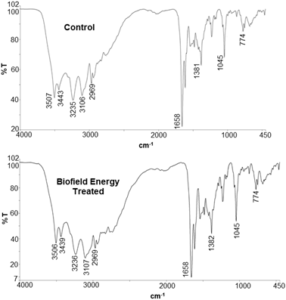
Figure 2: FT-IR spectra of the control and Biofield energy treated thiamine hydrochloride.
Ultra Violet-Visible Spectroscopy (UV-Vis) Analysis
The UV-vis spectra of both the control and Biofield Energy Treated samples are shown in Figure 3. The UV spectrum of the control sample showed the maximum absorbance at 202 nm (λmax) and 246 nm (λmax). The Biofield Energy Treated sample also showed similar peaks at 202 nm and 246 nm; however, there was a minor shift of absorbance maxima observed in the peak at 246 nm from 1.0908 (in the control sample) to 1.1412 in the Biofield Energy Treated sample. Thus, the UV-Vis studies indicated that the molecular structure and properties regarding λmax [38] of the control and Biofield energy treated sample remained the same.
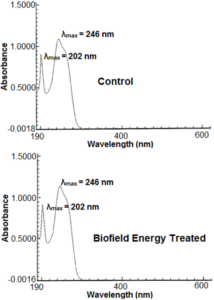
Figure 3: UV-vis spectra of the control and Biofield energy treated thiamine hydrochloride.
Thermal Gravimetric Analysis (TGA)/ Differential Thermogravimetric Analysis (DTG)
The thermal stability of the control and Biofield energy treated thiamine hydrochloride samples were studied using the TGA/DTG technique. The TGA thermograms of both the control and Biofield Energy Treated samples (Figure 4) showed three steps of thermal degradation. The data revealed that the Biofield energy treated thiamine hydrochloride showed a significant reduction in weight loss in 1st and 2nd steps of degradation by 5.17% and 1.86%, respectively. Although, there was an increase in the percentage weight loss in the 3rd step by 3.42%, however, the total weight loss in the Biofield Energy Treated thiamine hydrochloride was also decreased by 1.10%, compared to the control sample (Table 3). It showed that the thermal stability of the Biofield energy treated sample was significantly improved as compared to the control sample.
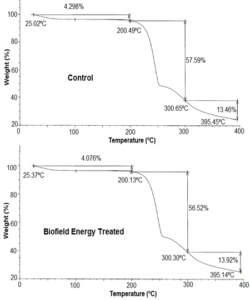
Figure 4: TGA thermograms of the control and Biofield energy treated thiamine hydrochloride.
Sample
TGA Weight loss (%)
DTG Tmax (oC)
1st step
2nd step
3rd step
Total
Peak 1
Peak 2
Control
4.298
57.59
13.46
75.348
245.41
297.30
Biofield Energy Treated
4.076
56.52
13.92
74.516
246.55
301.69
% Change*
-5.17
-1.86
3.42
-1.10
0.46
1.48
Tmax: Maximum thermal degradation temperature,
*denotes the percentage change in the weight loss of the treated sample compared to the control sample.
Besides, the DTG thermograms of both the control and Biofield energy treated samples (Figure 5) showed two peaks. Based on this, it was observed that the maximum degradation temperature (Tmax) corresponding to both the peaks of the Biofield Energy Treated sample was increased by 0.46% and 1.48%, respectively, as compared to the control sample. Overall, the TGA/DTG studies indicated that the thermal stability of the Biofield energy treated thiamine hydrochloride sample was improved as compared with the untreated sample.
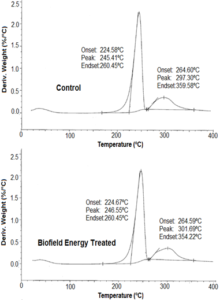
Figure 5: DTG thermograms of the control and Biofield energy treated thiamine hydrochloride.
Differential Scanning Calorimetry (DSC) Analysis
The DSC technique was used to study the melting, crystallization, and other thermal behaviors of the thiamine hydrochloride sample [32]. The DSC thermograms of both the control and the Biofield Energy Treated samples were shown in Figure 6. The thermograms of both the samples showed a sharp endothermic peak, which is considered as the melting temperature of the samples. It was observed at 252.83°C in the control sample; whereas at 253.53°C in the Biofield Energy Treated sample. Thus, the melting point of the Biofield Energy Treated sample was slightly increased by 0.28% compared to the control sample (Table 4). Moreover, the latent heat of fusion (ΔHfusion) of the Biofield energy treated sample was found to be 170.7J/g, which was significantly decreased by 35.24% compared with the control sample (263.6J/g).
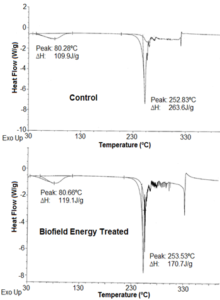
Figure 6: DSC thermograms of the control and Biofield energy treated thiamine hydrochloride. Peak 1 Peak 2
Peak
Description
Melting Point (°C)
ΔH(J/g)
Control sample
80.28
109.9
Biofield Energy Treated sample
80.66
119.1
% Change*
0.47
8.37
Control sample
252.83
263.6
Biofield Energy Treated sample
253.53
170.7
% Change*
0.28
-35.24
ΔH: Latent heat of evaporation/fusion; *denotes the percentage change of the Biofield energy treated sample compared to the control sample.
The DSC thermograms of the control and Biofield energy treated samples of thiamine hydrochloride also exhibited a small and broad endothermic inflection at 80.28 ºC and 80.66 ºC, respectively, which is considered to be resulted due to dehydration of water molecule present in the sample. Also, the control and Biofield energy treated samples showed the latent heat of evaporation (∆Hevaporation) as 109.9 and 119.1 J/g, respectively. The results suggested that the Biofield Energy Treated sample showed a slight increase in this temperature (0.47%) along with a significant increase in ∆H by 8.37% as compared to the control sample. The Biofield Energy Treatment may cause some alterations in the molecular chains and the crystallization structure of the thiamine hydrochloride [32], which might be responsible for the changes in ΔH. Also, the increase in melting and dehydration temperature indicated the improved thermal stability of the Biofield Energy Treated sample as compared to the untreated sample.
Conclusions
The overall results showed that the Trivedi Effect®-Consciousness Energy Healing Treatment possess a significant impact on the particle size, surface area, crystal, and thermal properties of the thiamine hydrochloride. The particle size values in the Biofield Energy Treated sample were significantly altered by 5.63% (d10), -6.27% (d50), -11.37% (d90), and -8.04% {D (4, 3)} compared to the control sample. Also, the specific surface area of the Biofield Energy Treated sample was observed to be significantly increased by 1.36% as compared to the control sample. Such alterations in the particle size and surface area might help in providing better solubility, dissolution, and absorption profile to the Biofield Energy Treated thiamine hydrochloride sample. The crystal properties involving PXRD studies showed the alteration in the relative intensities of the characteristic diffraction peaks of the Biofield Energy Treated sample ranging from -10.73% to 19.15% compared with the control sample. Also, the crystallite sizes across various planes in the Biofield Energy Treated sample were also significantly altered ranging from -11.77% to 14.29% compared with the control sample. Apart from that, the average crystallite size of the Biofield Energy Treated sample was also found to be decreased by 2.93% as compared with the control sample. Such changes might appear due to the alteration in the crystal morphology of the Biofield Energy Treated sample as compared to the untreated sample. Besides, the total weight loss of the Biofield Energy Treated thiamine was also decreased by 1.10%, compared to the control sample. Moreover, the increase in the Tmax of both the peaks of the Biofield Energy Treated sample was by 0.46% and 1.48%, respectively, as compared to the control sample. Thus, the data indicated that the significant improvement in the thermal stability of the Biofield Energy Treated thiamine compared with the untreated sample. Furthermore, the slight increase in the melting and dehydration temperature of the Biofield Energy Treated sample along with a significant alteration in the corresponding ΔH by 8.37 and -35.24%, respectively compared to the control sample. Thus, the Trivedi Effect® might help in producing a new polymorphic form of thiamine hydrochloride possessing higher solubility, dissolution rate, absorption, thermal stability, and bioavailability profile as compared to the untreated sample. The Consciousness Energy Healing Treated thiamine hydrochloride might offer better therapeutic response against several thiamine deficiency disorders, ulcerative colitis, poor appetite, diarrhea, diabetic pain, immunity booster, alcoholism, heart disease, cataract, glaucoma, cerebellar syndrome, canker sores, aging, motion sickness, Alzheimer's disease, Wernicke's encephalopathy syndrome, alcohol withdrawal, and preventing memory loss, etc.
Acknowledgements
The authors are grateful to GVK Biosciences Pvt. Ltd., Trivedi Science, Trivedi Global, Inc., Trivedi Testimonials, and Trivedi Master Wellness for their assistance and support during this work.
References
- Butterworth RF (2006) Thiamin. In: Shils ME (Ed). Modern Nutrition in Health and Disease, 10thEdn, Lippincott Williams & Wilkins, Baltimore, MD.
- Lonsdale D (2006) A review of the biochemistry, metabolism and clinical benefits of thiamin(e) and its derivatives. J Evid Based Complementary Altern Med 3: 49-59.
- Barminas J, Charles M, Emmanuel D (1998) Mineral composition of non-conventional leafy vegetables. Plant Foods Hum Nutr 53: 29-36.
- Lebiedzinska A, Szefer P (2006) Vitamins B in grain and cereal–grain food, soy-products and seeds. Food Chem 95: 116-122.
- Butterworth RF, Kril JJ, Harper CG (1993) Thiamine-dependent enzyme changes in the brains of alcoholics: Relationship to the Wernicke-Korsakoff syndrome. Alcohol Clin Exp Res 17: 1084-1088.
- DiNicolantonio JJ, Niazi AK, Lavie CJ, O'Keefe JH, Ventura HO (2013) Thiamine supplementation for the treatment of heart failure: A review of the literature. Congest Heart Fail 19: 214-222.
- Chandrakumar A, Bhardwaj A,’t Jong GW (2018) Review of thiamine deficiency disorders: Wernicke encephalopathy and Korsakoff psychosis. J Basic Clin Physiol Pharmacol 30: 153-162.
- Coombs G (1992) The Vitamins: Fundamental Roles in Nutrition and Health. Academic Press, New York.
- Osiezagha K, Ali S, Freeman C, Barker NC, Jabeen S, et al. (2013) Thiamine deficiency and delirium. Innov Clin Neurosci 10: 26-32.
- Cooper JR, Pincus JH (1979) The role of thiamine in nervous tissue. Neurochem Res 4: 223-239.
- Barnes PM, Bloom B, Nahin RL (2008) Complementary and alternative medicine use among adults and children: United States, 2007. Natl Health Stat Report 12: 1-23.
- Frass M, Strassl RP, Friehs H, Müllner M, Kundi M, et al. (2012) Use and acceptance of complementary and alternative medicine among the general population and medical personnel: A Systematic Review. Ochsner J 12: 45-56.
- Koithan M (2009) Introducing complementary and alternative therapies. J Nurse Pract 5: 18-20.
- Rubik B (2002) The biofield hypothesis: Its biophysical basis and role in medicine. J Altern Complement Med 8: 703-717.
- Trivedi MK, Branton A, Trivedi D, Nayak G, Nykvist CD, et al. (2017) Evaluation of the Trivedi Effect®-Energy of Consciousness Energy Healing Treatment on the physical, spectral, and thermal properties of zinc chloride. American Journal of Life Sciences 5: 11-20.
- Trivedi MK, Branton A, Trivedi D, Shettigar H, Bairwa K, et al. (2015) Fourier transform infrared and ultraviolet-visible spectroscopic characterization of biofield treated salicylic acid and sparfloxacin. Nat Prod Chem Res 3: 186.
- Trivedi MK, Patil S, Shettigar H, Bairwa K, Jana S (2015) Spectroscopic characterization of biofield treated metronidazole and tinidazole. Med chem 5: 340-344.
- Trivedi MK, Patil S, Shettigar H, Mondal SC, Jana S (2015) Evaluation of biofield modality on viral load of Hepatitis B and C viruses. J Antivir Antiretrovir 7: 083-088.
- Trivedi MK, Branton A, Trivedi D, Nayak G, Charan S, et al. (2015) Phenotyping and 16S rDNA analysis after biofield treatment on Citrobacter braakii: A urinary pathogen. J Clin Med Genom 3: 129.
- Trivedi MK, Patil S, Shettigar H, Mondal SC, Jana S (2015) An impact of biofield treatment: Antimycobacterial susceptibility potential using BACTEC 460/MGIT-TB System. Mycobact Dis 5: 189.
- Trivedi MK, Branton A, Trivedi D, Nayak G, Mondal SC, et al. (2015) Morphological characterization, quality, yield and DNA fingerprinting of biofield energy treated alphonso mango (Mangiferaindica). Journal of Food and Nutrition Sciences 3: 245-250.
- Trivedi MK, Branton A, Trivedi D, Nayak G, Mondal SC, et al. (2015) Evaluation of biochemical marker – glutathione and DNA fingerprinting of biofield energy treated Oryza sativa. American Journal of Bio Science 3: 243-248.
- Trivedi MK, Branton A, Trivedi D, Nayak G, Mondal SC, et al. (2015) Effect of biofield treated energized water on the growth and health status in chicken (Gallus gallusdomesticus). Poult Fish Wildl Sci 3: 140.
- Trivedi MK, Tallapragada RM, Branton A, Trivedi D, Nayak G, et al. (2015) The potential impact of biofield energy treatment on the physical and thermal properties of silver oxide powder. International Journal of Biomedical Science and Engineering 3: 62-68.
- Trivedi MK, Tallapragada RM, Branton A, Trivedi D, Nayak G, et al. (2015) Analysis of physical, thermal, and structural properties of biofield energy treated molybdenum dioxide. International Journal of Materials Science and Applications 4: 354-359.
- Nayak G, Altekar N (2015) Effect of biofield treatment on plant growth and adaptation. J Environ Health Sci 1: 1-9.
- Kinney JP, Trivedi MK, Branton A, Trivedi D, Nayak G, et al. (2017) Overall skin health potential of the biofield energy healing based herbomineral formulation using various skin parameters. American Journal of Life Sciences 5: 65-74.
- Trivedi MK, Branton A, Trivedi D, Nayak G, Plikerd WD, et al. (2017) A Systematic study of the biofield energy healing treatment on physicochemical, thermal, structural, and behavioral properties of magnesium gluconate. International Journal of Bioorganic Chemistry 2: 135-145.
- Trivedi MK, Branton A, Trivedi D, Nayak G, Lee AC, et al. (2017) A comprehensive analytical evaluation of the Trivedi Effect®-Energy of Consciousness Healing Treatment on the physical, structural, and thermal properties of zinc chloride. American Journal of Applied Chemistry 5: 7-18.
- Trivedi MK, Branton A, Trivedi D, Nayak G, Plikerd WD, et al. (2017) A systematic study of the biofield energy healing treatment on physicochemical, thermal, structural, and behavioral properties of iron sulphate. International Journal of Bioorganic Chemistry 2: 135-145.
- Langford JI, Wilson AJC (1978) Scherrer after sixty years: A survey and some new results in the determination of crystallite size. J Appl Cryst 11: 102-113.
- Mosharrof M, Nystrӧm C (1995) The effect of particle size and shape on the surface specific dissolution rate of microsized practically insoluble drugs. Int J Pharm 122: 35- 47.
- Zhao Z, Xie M, Li Y, Chen A, Li G, et al. (2015) Formation of curcumin nanoparticles via solution enhanced dispersion by supercritical CO2. Int J Nanomedicine 10: 3171-3181.
- Trivedi MK, Branton A, Trivedi D, Nayak G, Lee AC, et al. (2017) Evaluation of the impact of biofield energy healing treatment (the Trivedi Effect®) on the physicochemical, thermal, structural, and behavioural properties of magnesium gluconate. International Journal of Nutrition and Food Sciences. 6: 71-82.
- Trivedi MK, Branton A, Trivedi D, Nayak G, Plikerd WD, et al. (2017) Evaluation of the physicochemical, spectral, thermal and behavioral properties of sodium selenate: Influence of the energy of consciousness healing treatment. American Journal of Quantum Chemistry and Molecular Spectroscopy 2: 18-27.
- Raza K, Kumar P, Ratan S, Malik R, Arora S (2014) Polymorphism: The phenomenon affecting the performance of drugs. SOJ Pharm Pharm Sci 1: 10.
- Stuart BH (2004) Infrared spectroscopy: Fundamentals and applications in Analytical Techniques in the Sciences. John Wiley & Sons Ltd., Chichester, UK.
- Hesse M, Meier H, Zeeh B (1997) Spectroscopic methods in organic chemistry, Georg Thieme Verlag Stuttgart, New York.